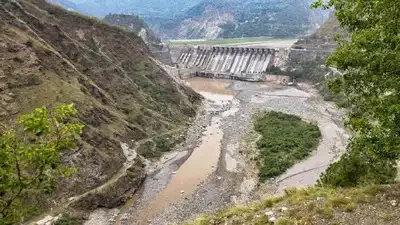
Pakistan’s wariness over an impending agricultural crisis has intensified, with official statistics confirming a 15 per cent dip in water release from key dams compared to this time last year. On 5 June, discharge from major reservoirs in Punjab fell to 124,000 cusecs, down from 144,000 cusecs on the same date in 2024—a fall that threatens both irrigation for farms and hydropower generation.
Levels at the Tarbela and Chashma reservoirs are hovering perilously close to their ‘dead storage’ thresholds. Tarbela, on the Indus, registered a level of 1,465 m—just 63 m above its dead level of 1,402 m. Chashma dropped to 644 m, only 6 m of dead storage remaining, and Mangla, on the Jhelum, slid to 1,163 m, within 113 m of its critical threshold. The gravity-fed release mechanism risks failure if levels fall below these limits.
Flow in the Chenab at Marala, Sialkot, plunged from about 26,645 cusecs on 28 May to 3,064 cusecs by 5 June—a near 90 per cent collapse in less than a week. The Indus River System Authority estimates an overall water shortfall of 21 per cent for the early Kharif season, which spans until 10 June.
Agriculture accounts for nearly a quarter of Pakistan’s GDP, employs over a third of its workforce, and consumes almost 94 per cent of water withdrawals. The domino effect of dwindling water supplies threatens crop sowing, food security, farm livelihoods, and electricity from hydropower—particularly as the sowing window for summer crops approaches.
Heightened geopolitical discord has layered additional complexity onto the crisis. India suspended its involvement in the 1960 Indus Waters Treaty, citing the April attack in Pahalgam, and has taken steps to regulate flows in the western rivers, primarily the Chenab. Following that suspension, India has stopped sharing real-time flow data and lowered gates at Baglihar and possibly Kishanganga dams—moves Islamabad calls “an act of war”.
Analysts note that despite the political posturing, India currently lacks sufficient reservoir infrastructure to entirely cut off water flows. Experts describe the actions as “small disturbances” that could significantly disrupt Pakistan’s agriculture, especially during low-flow seasons.
Pakistan’s reliance on external water sources is profound. Over 75 per cent of its renewable water comes from cross-border sources, mainly the Indus Basin, which supports 90 per cent of its food production and one-fifth of its hydropower. The system has scant buffer: sediment accumulation over decades has reduced dam capacities, with no major new reservoirs added since Tarbela’s construction in 1976.
Climate change compounds the challenge. Glacial runoff in the Upper Indus Basin has fluctuated dramatically, while groundwater storage has seen persistent depletion over recent decades. GRACE satellite data indicates that groundwater decline has accelerated from −0.65 cm per year before 2015 to −2.16 cm per year thereafter. In addition, erratic rainfall, melting glaciers, and increasingly extreme weather patterns heighten water insecurity.
Pakistan’s infrastructure constraints worsen vulnerability. The Babarloi protests in Sindh have demonstrated local resistance to canal expansion projects under national water-resource policies, underscoring the difficulty of inter-provincial water-sharing and internal planning in times of scarcity.
Government is encouraging emergency measures—directive from IRSA urges dam managers and irrigation authorities to “use water judiciously”. Prime Minister Shehbaz Sharif has highlighted Pakistan’s plight at a glacier preservation forum in Dushanbe, pressing for international focus on the treaty’s suspension and water distribution.
Farmers, meanwhile, face harsh realities. Irrigation-dependent zones, particularly in Punjab and Sindh, may see severe crop failings. Experts warn soil salinisation and waterlogging from overuse of limited water could further degrade soil quality. Small farmers fear devastation, and terms like “starve us” have surfaced in local narratives.
Hydropower generation is also under threat. With reservoir levels near dead storage, electricity production from Tarbela, Mangla, and Chashma is expected to fall, fuelling anticipated load‑shedding and impacting industrial productivity and urban supplies.
Environmental risks loom as well. Altered flow patterns increase salinity in the Indus Delta, damaging mangrove ecosystems and aquatic species, notably the Indus dolphin population, now fragmented by upstream structures.
Options for mitigation are limited. Monsoon rainfall expected in July could offer relief, but its timing and distribution are unpredictable. Long‑term remedies—such as enhancing storage infrastructure, dredging to reduce silt, groundwater recharge, and diversification to less water‑intensive crops—face funding, political, and environmental challenges.
Tensions between India and Pakistan add a critical geopolitical dimension. Islamabad has warned that any unilateral moves to block water, or withhold hydrological data, may constitute acts of war. New Delhi maintains it currently cannot fully obstruct water flows but insists treaty suspension is lawful following security incidents.
Pakistan has announced its intention to pursue legal action via the Permanent Court of Arbitration and the World Bank, invoking treaty clauses governing dispute resolution. However, the effectiveness and timeline of these efforts remain uncertain.
As Pakistan moves deeper into the critical Kharif sowing phase, its agricultural future hangs in the balance. With nationally and regionally low water levels, geopolitical strain, a changing climate, and ageing infrastructure, farmers, policymakers, and energy planners brace for a season that may define Pakistan’s resilience and regional water dynamics in the years to come.




 RBI Looks At Tighter Rules To Curb Mis-Selling Of Financial Products
RBI Looks At Tighter Rules To Curb Mis-Selling Of Financial Products 